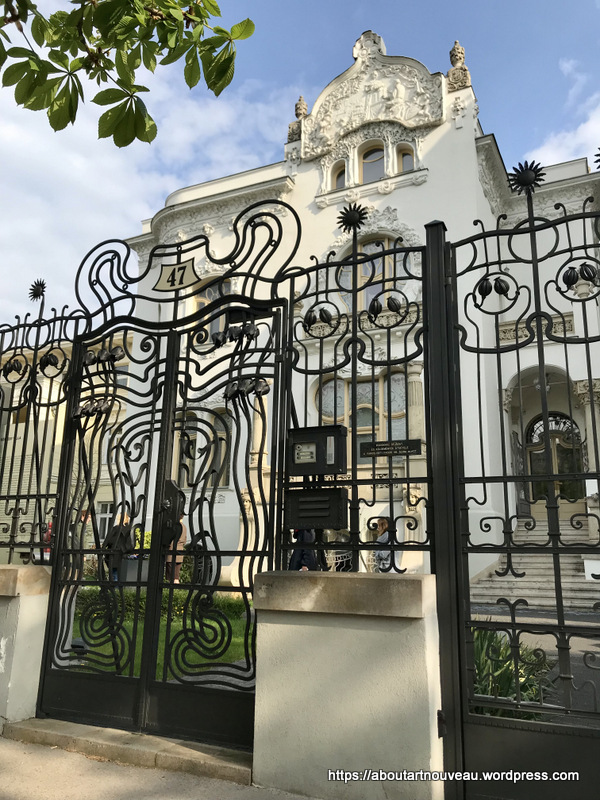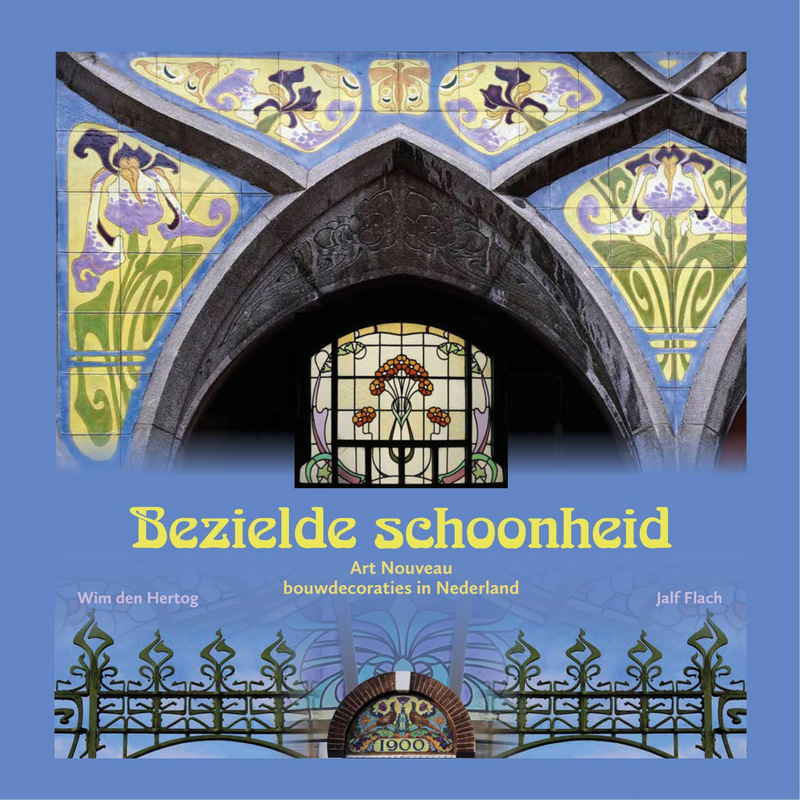
A few weeks ago, I participated in a meeting of the Réseau Art Nouveau Network (RANN), which was splendidly organised by the Museum of Applied Arts in Budapest. During our meeting, we visited several important Szecesszió (Art Nouveau) venues, one of them being the beautiful Villa Kőrössy. Of course I wanted to share some of my photos of this wonderful villa with you. But I decided to ask someone else to write the story for you.

Eszter Baldavári, Art Historian, in front of Villa Kőrössy
This is a guest-blog by my dear friend Eszter Baldavári. Eszter is an art historian who works for the Hungarian Museum of Architecture and Monument Protection Documentation Center, in Budapest. She has investigated the life and work of the architect of Villa Kőrössy, Albert Kálmán Kőrössy, for many years and she has even published a book about him. So who better to tell you this story than Eszter Baldavári?! Enjoy!

Villa Kőrössy, 47 Városligeti Fasor, Budapest
Albert Kálmán Kőrössy, architect
Albert Kálmán Kőrössy was born on 15 June 1869 in Szeged. In 1887 he started his studies in architecture at the Technical University of Budapest, and during his studies he visited the École des Beaux-Arts in Paris. Then, around 1890-1891, the Technische Hochschule in Munich, where his professor was Friedrich von Thiersch (1852–1921). Although Von Thiersch was one of the most well-known figures of German Neo-Baroque architecture, at the end of his lifetime Jugendstil forms started to appear on the façades of the buildings he designed. Kőrössy probably learnt about the Art Nouveau movement (which was called Jugendstil in Munich) via the works of Von Thiersch. And maybe also via the works of Martin Dülfer (1859-1942), who worked in the architectural studio of professor Von Thiersch.

After Kőrössy had graduated as an architect in 1891, he returned to Budapest and became an employee of Alajos Hauszmann (1847-1926), the architect of the Royal Palace in Buda. One of the first projects Kőrössy was involved in was the New York Palace (1890-1894) where he got acquainted with Arthúr Sebestyén (1868-1945). Kőrössy and Sebestyén started an architecture studio together, and between 1896 and 1899 they designed several apartment buildings and mansions in Budapest. In their works we can discover the Neo-Baroque forms that were influenced by Alajos Hauszmann. But at the same time we are beginning to see traces of the major European trend of that time, the early Jugendstil.

Villa Kőrössy, 1904
Villa Kőrössy
The most impressive example of Jugendstil architecture in Budapest is Albert Kálmán Kőrössy’s own villa. In 1899 Kőrössy had parted ways with Sebestyén and opened his own office in a newly constructed villa at 47 Városligeti Allee. After he got married, the young architect settled down in that same villa with his wife, Dóra Paula Román (Rosenberg), who was related to the famous Paul Rosenberg, Picasso’s art dealer.

The design of the villa was influenced by the early Jugendstil. Kőrössy chose botanically correct plant motifs and carefully formed animal figures from the Hungarian flora and fauna. The façade is richly ornamented with plasterwork. On the first floor, there is an omega shaped window. And the groundfloor window is decorated with a lion’s head, hidden behind an enormous pear tree’s branches. A similar design could be observed on the Lottery Palace in Budapest (that was demolished during WWII) which Kőrössy and Sebestyén designed a year earlier.

Between the attic windows there are tree trunks reaching upwards, entwined into a single lush crown on the hood moulding. The sunflower-and-rose-framed gable is filled by a relief depicting allegories of Art (painting, sculpture and architecture). If we take a closer look at the figure symbolising Architecture, we can observe that it is actually Kőrössy himself, examining the model of the very villa.

In the interior, the decorative brass handles mostly retain their original form, just like the tendril-and-leaf railing of the stairs, which leads our eyes to a vast stained glasswindow with figures of irises and a stork, created by Miksa Róth. The original colourful plans of the window can be found today in the collection of the Wolfsonian–Florida International University, Miami.
If we look at the structure of the façade and the style of the ornaments, Albert Kálmán Kőrössy’s first designs are the most significant examples of early Jugendstil – rather than of the Hungarian National Style – in Budapest. We can find similar designs on buildings in Germany. In Cottbus for instance, at 41 Bautzenerstrasse (1903) and 48 Schillerstrasse (Friedrich Dümpert–Hermann Hauke, 1901-1902). And the omega-shape window looks like that of the house at 47 Zimmermannstrasse, in Stuttgart.
Atelier and stables behind Villa Kőrössy
Since the architect received more and more commissions, not only from Budapest but from all over Hungary (from Nyíregyháza to Bratislava, in today’s Slovakia), he needed a more spacious studio. The new studio was constructed at the end of the long plot behind Villa Kőrössy in 1903. It became a rare example of an architectural studio at a time when ateliers were furnished in apartments of tenement houses. The state-of-art building was covered in detail in the 1904 Architectural Survey, saying that from its French balcony “1:1 scale drawings of details can be rolled down, and their three-dimensional effect better judged from the garden.”

Atelier behind Villa Kőrössy, 1903
We know from Kőrössy’s descendants that the architect had horses and that he was a great fan of horse. According to the plans of the Metropolitan Archive he designed a stable for 4 horses that was placed in the middle of plot: between the villa and the atelier. The building was built in 1910 and the contractor was Benő Bihari, one of Kőrössy’s employees at the atelier.

RANN-members visiting Villa Kőrössy during the GA in April 2023
The Story of The Villa Till Now
During WWI, the Kőrössy family decided to open a private hospital (mentioned as Hilfsspital) with rooms for ten beds and an other room for operations and medical treatments. During WWII, Albert Kálmán Kőrössy needed to sell his villa urgently, before it would be confiscated by the fascist regime. After the war, an Offset Printing-House moved into the ruined building…
At the end of the 1990s the company Resonator Inc. bought the damaged villa and started its reconstruction in 1998. The restoration was designed by Flóra Csabai (architect) and Ágnes Reichard (interior designer) who received the Architectural Level Award of Budapest in 1999 for their work on the villa.
Today the owners of the Villa are preparing for the public opening of the building, representing a gem of the Art Nouveau architecture in Budapest, and showing their unique Zsolnay ceramic collection as a private museum. Until then, please enjoy these few photos taken during the RANN-meeting in April 2023.
Thank you to Eszter Baldavári for the excellent tour of the Villa and this guest blog. And thank you to the owners of Villa Kőrössy for inviting us RANN-members into their architectural gem and sharing their Zsolnay collection with us! Köszönöm!
Continue Reading
Discover the lavish Kőrössy Villa neglected for decades
Top 15 Must See Art Nouveau Gems in Budapest
Villa Kőrössy – refreshing elegance on the Városliget tree line
www.korossyszalon.hu












